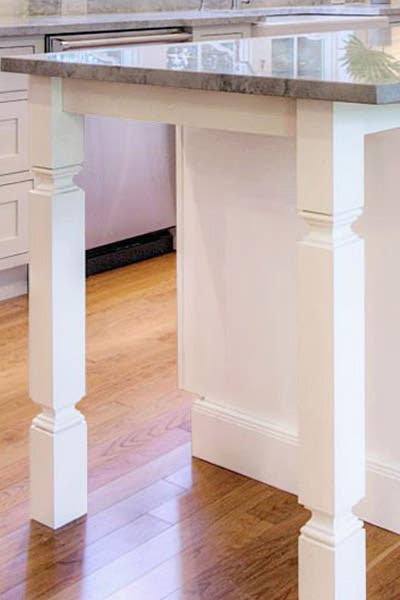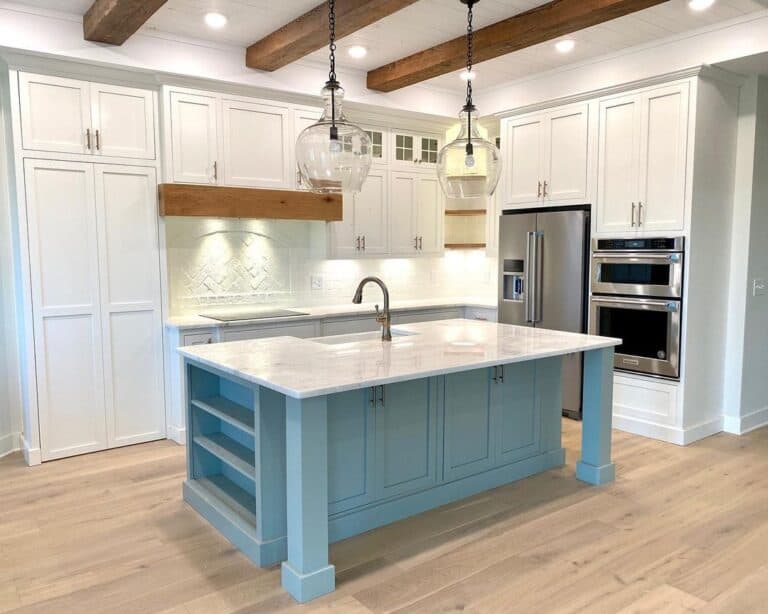Essential Factors to Think About When Picking Legs For Kitchen Island
Picking the appropriate legs for a cooking area island involves a cautious evaluation of multiple factors that can considerably influence both functionality and visual charm. As we check out these aspects, it ends up being clear that each choice can have far-reaching effects for the overall kitchen area experience.
Material Options
When picking legs for a kitchen area island, understanding the numerous material alternatives is crucial for accomplishing both visual allure and structural honesty (Legs For Kitchen Island). The choice of product substantially influences not only the resilience of the island yet additionally its total design and capability
Wood is a preferred selection, providing warmth and versatility. Solid hardwoods, such as oak or maple, supply toughness and can be discolored or repainted to match the cooking area design. Steel legs, frequently made from stainless-steel or wrought iron, contribute a contemporary and industrial feeling while making sure longevity and stability. These materials are immune to wear and can support substantial weight, making them optimal for larger islands.
An additional option is engineered materials, like MDF or plywood, which can be a lot more economical while still using a variety of finishes. They may not give the exact same degree of stability as solid timber or steel. Legs For Kitchen Island. Materials such as acrylic or glass can create a modern look, though they may need added assistance to make sure security.
Eventually, the selection of material for kitchen area island legs must align with the preferred performance and the total motif of the kitchen area.
Design And Style

When taking into consideration style, the form and coating of the legs are crucial. Tapered legs can provide a feeling of lightness and beauty, while thicker, more durable legs can communicate stamina and stability. In addition, the coating-- be it painted, tarnished, or all-natural-- should complement the cabinetry and kitchen counter products to produce a unified look.
Additionally, the design of the legs can additionally show individual taste. Custom-made or attractive legs, such as those featuring intricate carvings or special geometric forms, can act as focal factors, adding personality and personality to the kitchen. Eventually, the right selection will not just boost performance but additionally raise the visual allure, making the kitchen area island a standout attribute of the home.
Elevation Considerations
Picking the appropriate elevation for kitchen island legs is vital, as it directly impacts both performance and convenience. The typical height for a cooking area island typically ranges from 36 to 42 inches, straightening with common countertop elevations. A 36-inch elevation is ideal for cooking and cooking, enabling for comfortable use of cooking area home appliances and devices. Conversely, an elevation of 42 inches is typically preferred for islands meant for bar seats, accommodating taller stools and supplying an informal dining experience.

It is additionally important to make up users' choices and elevations. Customizing the elevation can ensure a comfy experience for all relative, making the kitchen island an extra delightful and practical area.
Weight Support
Guaranteeing appropriate weight support for kitchen area island legs is essential for both safety and security and capability. The cooking area island usually serves numerous objectives, including food preparation, eating, and extra storage, necessitating a robust support framework. When choosing legs, it is critical to take into consideration the total weight capability required based upon the island's intended use and the products that will certainly be put on it.
The option of product for the legs plays a considerable function in their weight-bearing capacities. Solid timber, steel, and sturdy composites normally provide superior strength contrasted to lighter products. In addition, the layout of the legs-- whether they are right, tapered, or have a pedestal kind-- can influence their capacity to distribute weight properly across the structure.
Furthermore, the leg positioning need to be purposefully planned to enhance stability. Legs positioned at the edges or with a larger base can much better support heavier lots. Always consult the supplier's specifications concerning load limitations to make sure that the legs can sustain the desired weight without jeopardizing safety. In summary, choosing cooking area island legs with ample weight support is crucial for developing a risk-free and useful cooking room.
Installment and Maintenance
Correct installation and maintenance of kitchen island legs are essential for guaranteeing longevity and security. This usually includes protecting the legs to the island base utilizing suitable bolts, making sure that the legs are level and aligned.
When installed, regular upkeep is needed to maintain the integrity and look of the legs - Legs For Kitchen Island. For wood legs, periodic cleansing see this with a wet fabric and application of suitable wood polish can avoid moisture damages and keep their surface. Metal legs go to these guys might require a mild cleansing solution to eliminate grease and gunk, followed by a completely dry towel to stop rust formation
Furthermore, evaluate the legs consistently for indications of wear or damage, such as cracks or loose joints. Tightening up screws or bolts as needed can likewise lengthen the life-span of the legs. By adhering to these installation and upkeep methods, homeowners can make certain that their kitchen island continues to be sturdy and visually appealing for several years to find.
Final Thought

Visual coherence is extremely important in choosing the design and design of legs for a kitchen area island, as these aspects considerably influence the general atmosphere of the space. Conical legs can give a sense of agility and style, while thicker, a lot more robust legs can convey stamina and stability.Picking the proper height for kitchen area island legs is vital, as it straight influences both functionality and comfort. In summary, selecting kitchen area island legs with ample weight assistance is essential for producing a practical and safe culinary room.
In verdict, selecting legs for a kitchen area island demands mindful consideration of numerous elements, including product alternatives, design, height, weight assistance, and installment.